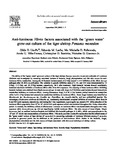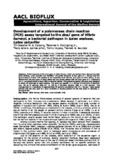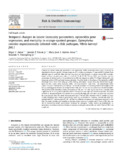Search
Now showing items 1-10 of 28
Induction of immunity and resistance to white spot syndrome virus (WSSV) in shrimp Penaeus monodon (Fabricius) by synthetic oligodeoxynucleotide and bacterial DNA
(University of the Philippines Los Baños, 2012)
Shrimps like all invertebrates are believed to lack true adaptive immunity but recent evidence indicate that they can be protected against pathogenic organisms by priming their immune system with immunostimulatory substances. ...
Evaluation of dietary freeze-dried Chaetoceros calcitrans supplementation to control Vibrio harveyi infection on Penaeus monodon juvenile
(Elsevier, 2014)
Effects of supplementation of diets with freeze-dried Chaetoceros calcitrans to control Vibrio harveyi infection are evaluated through immune responses, and disease resistance of juvenile Penaeus monodon. Total lipid and ...
Dietary onion or ginger modulates the stress response and susceptibility to Vibrio harveyi JML1 infection in brown-marbled grouper Epinephelus fuscoguttatus juveniles
(American Fisheries Society, 2018)
Onion Allium cepa and ginger Zingiber officinale have health‐promoting properties that qualify them as functional foods. The effect of repeated acute stressors was examined in juvenile Brown‐marbled Grouper Epinephelus ...
Growth, plasma cortisol, liver and kidney histology, and resistance to vibriosis in brown-marbled grouper, Epinephelus fuscoguttatus fed onion and ginger
(Bioflux, 2013)
The health-promoting effects of dietary onion and ginger were studied in brown marbled grouper, Epinephelus fuscoguttatus. An eight-week feeding trial was conducted to evaluate the effects of dietary onion and ginger on ...
Anti-luminous Vibrio factors associated with the ‘green water’ grow-out culture of the tiger shrimp Penaeus monodon
(Elsevier, 2005)
The ability of the “green water” grow-out culture of the tiger shrimp Penaeus monodon to prevent outbreaks of Luminous Vibriosis was investigated by screening associated isolates of bacteria, fungi, phytoplankton and fish ...
Antibacterial activity of tilapia Tilapia hornorum against Vibrio harveyi
(Elsevier, 2004)
Disease due to luminous Vibrio has been a major problem of the shrimp industry. Different technologies have been introduced to control the disease. One of the techniques reported to work against luminous bacteria in the ...
Development of a polymerase chain reaction (PCR) assay targeted to the dnaJ gene of Vibrio harveyi, a bacterial pathogen in Asian seabass, Lates calcarifer
(Bioflux, 2011)
Partial sequence of the dnaJ gene of Vibrio harveyi, which was isolated from diseased juvenile Asian seabass, Lates calcarifer was identified. The partial sequence of dnaJ gene of V. harveyi was 447 bp and shared at least ...
Studies on the chemical control of luminous bacteria Vibrio harveyi and V. splendidus isolated from diseased Penaeus monodon larvae and rearing water
(Inter Research, 1990)
The minimum inhibitory concentrations (MICs) and minimum bactericidal concentrations (MBCs) of 24 drugs for luminous bacteria Vibrio harveyi and V. splendidus were determined. Only chloramphenicol, sodium nifurstyrenate ...
Screening of vibriosis in Asian seabass, Lates calcarifer using loop-mediated isothermal amplification (LAMP) assay
(Bioflux Society, 2012)
The aim of this study was to standardize a loop-mediated isothermal amplification (LAMP) assay for the detection of <i>Vibrio harveyi</i> , the causative agent of vibriosis in Asian seabass, <i>Lates calcarifer</i>. The ...
Temporal changes in innate immunity parameters, epinecidin gene expression, and mortality in orange-spotted grouper, Epinephelus coioides experimentally infected with a fish pathogen, Vibrio harveyi JML1
(Elsevier, 2017)
Changes in innate immunity parameters and epinecidin mRNA transcript levels were examined to characterize the non-specific immune response of E. coioides to pathogenic V. harveyi JML1 isolated from affected cage-cultured ...











